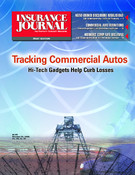Watch out! That mobile drilling unit you assume is covered under your insured’s commercial general liability policy as a piece of mobile equipment could be considered a commercial vehicle according to the insurance company.
When Insurance Services Offices Inc. (ISO) came out with a new commercial general liability policy last year, it changed, among other things, the definition of “mobile equipment.” That change under the widely used 2004 CGL policy could mean the beat-up old truck that your insured never drives off his property could now be considered a commercial auto for liability purposes, although it was formerly tagged as mobile equipment.
“The CGL policy now says that certain land vehicles that are now subject to the financial responsibility laws within the state have to be on the business auto policy, which is the crux of the problem,” said Wes Bailey, president of Bailey Insurance and Financial Services in Waco, Texas.
Bailey, who teaches commercial insurance at Baylor University in Waco and conducts CGL classes around the country, said every state has a different financial responsibility law, so whether a vehicle is considered to be mobile equipment varies by state. And, he warned, now some land vehicles that used to be considered mobile equipment, the liability for which was covered under the GL policy, now need to be placed on the commercial auto policy for liability coverage.
Which policy?
As an example, he said, consider “a truck that provides mobility to a permanently mounted drill. It is used for construction purposes. You’ve seen these trucks on the highway. It’s a truck and it has a drill mounted on the back, kind of at an angle. They’re going to back that truck up, put that drill in place and they’re going to drill a pier for a construction foundation. You never had to put that on the auto policy, but now you have to put the truck itself on the business auto policy for liability protection.”
However, Bailey added, when the drill is moved into place on the construction site, the liability coverage reverts to the CGL policy.
Bailey cited another example–a flat bed truck used only on the owner’s premises, such as a brickyard covering a five- or six-acre lot. The truck is used to move bricks from one end of the lot to the other. “The old policy–the CGL–would say that if that truck was used on the premises, you didn’t have to put it on the auto policy [because] the CGL would respond,” he explained.
Now, with the wording regarding the financial responsibility laws and because the truck is designed for highway use, it is subject to the financial responsibility act–at least in Texas and possibly in other states. Consequently, the truck needs to be scheduled under the business auto policy. And agents need to be aware of the financial responsibility laws in their state, since the laws vary by state.
Choose symbols wisely
Bailey noted that because of the change in ISO’s CGL policy, selection of the symbol number for use on the auto liability policy is critical. The symbol number on the policy defines the vehicle or vehicles the policy will cover.
If you use the symbol “1” on the commercial auto policy, “then the policy is going to cover the insured for the liability arising from any automobile,” Bailey said. However, depending on the state in which the policy is written, some insurers may prefer to use the symbols “7,” “8” and “9,” which specify the vehicles covered by the policy. The symbol “7” is used for specifically described vehicles, and those vehicles need to be listed individually on the policy; “8” is for hired autos, such as a rented vehicle; and “9” covers non-owned vehicles, such as an employee’s personal car that he or she uses for business purposes.
Where it gets tricky, he said, is if you use “7,” “8” and “9,” instead of the all-encompassing symbol “1.” If the agent forgets to describe a vehicle or the insured forgets to tell the agent about a vehicle and it doesn’t get listed on the policy, it won’t be covered. A vehicle that was formerly known as mobile equipment but is now categorized as a business vehicle could easily be left off the commercial auto policy, Bailey said.
“That’s why you want to use the symbol ‘1,’ he said, because it leaves room for error.”
Was this article valuable?
Here are more articles you may enjoy.


 FBI Says Chinese Hackers Preparing to Attack US Infrastructure
FBI Says Chinese Hackers Preparing to Attack US Infrastructure  AIG Sues Newly Launched Dellwood Insurance and Its Founders
AIG Sues Newly Launched Dellwood Insurance and Its Founders  USAA to Lay Off 220 Employees
USAA to Lay Off 220 Employees  North Carolina Adjuster and Son Charged With Embezzlement in Roof Jobs
North Carolina Adjuster and Son Charged With Embezzlement in Roof Jobs 


